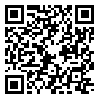Volume 33, Issue 230 (2-2024)
J Mazandaran Univ Med Sci 2024, 33(230): 70-84 |
Back to browse issues page
Download citation:
BibTeX | RIS | EndNote | Medlars | ProCite | Reference Manager | RefWorks
Send citation to:



BibTeX | RIS | EndNote | Medlars | ProCite | Reference Manager | RefWorks
Send citation to:
Yousefi-Reykandeh S S, Bagherpour-Reykandeh M M, Hosseinnataj A, Ghavami S J, Bakooie I, Khodabakhshi A R et al . The Mediating Role of Alexithymia in the Relationship between Social Support and Death Anxiety in Hemodialysis Patients:
A Structural Equation Model Analysis. J Mazandaran Univ Med Sci 2024; 33 (230) :70-84
URL: http://jmums.mazums.ac.ir/article-1-20252-en.html
URL: http://jmums.mazums.ac.ir/article-1-20252-en.html
Seyed Sajjad Yousefi-Reykandeh 

 , Mohammad Mahdi Bagherpour-Reykandeh
, Mohammad Mahdi Bagherpour-Reykandeh 

 , Abolfazl Hosseinnataj
, Abolfazl Hosseinnataj 

 , Seyed Javad Ghavami
, Seyed Javad Ghavami 

 , Iman Bakooie
, Iman Bakooie 

 , Amir Reza Khodabakhshi
, Amir Reza Khodabakhshi 

 , Masoumeh Bagheri-Nesami
, Masoumeh Bagheri-Nesami 




 , Mohammad Mahdi Bagherpour-Reykandeh
, Mohammad Mahdi Bagherpour-Reykandeh 

 , Abolfazl Hosseinnataj
, Abolfazl Hosseinnataj 

 , Seyed Javad Ghavami
, Seyed Javad Ghavami 

 , Iman Bakooie
, Iman Bakooie 

 , Amir Reza Khodabakhshi
, Amir Reza Khodabakhshi 

 , Masoumeh Bagheri-Nesami
, Masoumeh Bagheri-Nesami 


Abstract: (2210 Views)
Background and purpose: Hemodialysis patients often face various psychological challenges that can significantly affect their overall health. Alexithymia is a construct that refers to the inability to distinguish between emotions and bodily reactions, difficulty describing emotions to others, and a cognitive style that is driven by reality and concrete situations. Various studies have shown that alexithymia is significantly and positively correlated with many psychiatric disorders. Moreover, as a factor, it hurts mental health (especially anxiety) and the quality of life of hemodialysis patients. Therefore, this research aimed to determine the mediating role of alexithymia in the relationship between social support and death anxiety in hemodialysis patients.
Materials and methods: This cross-sectional and analytical study was conducted on 235 patients at Sari Shahrvand dialysis center, Iran 2023. Patients were included in the study by convenient sampling method. Data collection was done using demographic information questionnaires, Templer's Death Anxiety Scale (DAS-15), Zimmet's Multidimensional Scale of Perceived Social Support (MSPSS), and Toronto Alexithymia Scale (TAS-20). Demographic information included gender, place of residence, level of education, duration of hemodialysis treatment, number of visits per week, history of underlying diseases, and history of hemodialysis. Templer's death anxiety scale includes 15 questions in the form of a 5-point Likert scale regarding thoughts of death, fear of death, talking about death, fear, and thinking about incurable diseases. Zimmet's multidimensional scale of perceived social support is a 12-question instrument in the form of a 7-point Likert scale, which was used to evaluate perceived social support from three subscales of friends, family, and significant others. The Toronto Alexithymia Scale was a 20-question questionnaire with a five-point Likert scale, with three subscales: difficulty in recognizing emotions, difficulty in describing emotions, and objective thinking (Externally oriented), which was used to evaluate alexithymia. Finally, the data was analyzed by descriptive statistics and structural equation modeling with the bootstrap method, utilizing SPSS 26 and AMOS 22.
Results: The study revealed that most participants were male, comprising 58.3% of the statistical population. The average scores for death anxiety, perceived social support, and alexithymia were 38.97±10.31, 4.88±1.26, and 55.72±9.76, respectively. The results suggest that there is no statistically significant relationship between social support scores and death anxiety (B=-0.13 (-0.30, 0.04), P=0.153), nor between social support and alexithymia (B=-0.12 (-0.28, 0.09), P=0.256). However, there is a significant and direct relationship between alexithymia and death anxiety (B=0.66 (0.46, 0.82), P=0.016).
Conclusion: Considering the significant and direct relationship between alexithymia and death anxiety, it is recommended that managers and healthcare planners regularly evaluate the presence of death anxiety and alexithymia among individuals and formulate targeted interventions to alleviate these conditions.
Materials and methods: This cross-sectional and analytical study was conducted on 235 patients at Sari Shahrvand dialysis center, Iran 2023. Patients were included in the study by convenient sampling method. Data collection was done using demographic information questionnaires, Templer's Death Anxiety Scale (DAS-15), Zimmet's Multidimensional Scale of Perceived Social Support (MSPSS), and Toronto Alexithymia Scale (TAS-20). Demographic information included gender, place of residence, level of education, duration of hemodialysis treatment, number of visits per week, history of underlying diseases, and history of hemodialysis. Templer's death anxiety scale includes 15 questions in the form of a 5-point Likert scale regarding thoughts of death, fear of death, talking about death, fear, and thinking about incurable diseases. Zimmet's multidimensional scale of perceived social support is a 12-question instrument in the form of a 7-point Likert scale, which was used to evaluate perceived social support from three subscales of friends, family, and significant others. The Toronto Alexithymia Scale was a 20-question questionnaire with a five-point Likert scale, with three subscales: difficulty in recognizing emotions, difficulty in describing emotions, and objective thinking (Externally oriented), which was used to evaluate alexithymia. Finally, the data was analyzed by descriptive statistics and structural equation modeling with the bootstrap method, utilizing SPSS 26 and AMOS 22.
Results: The study revealed that most participants were male, comprising 58.3% of the statistical population. The average scores for death anxiety, perceived social support, and alexithymia were 38.97±10.31, 4.88±1.26, and 55.72±9.76, respectively. The results suggest that there is no statistically significant relationship between social support scores and death anxiety (B=-0.13 (-0.30, 0.04), P=0.153), nor between social support and alexithymia (B=-0.12 (-0.28, 0.09), P=0.256). However, there is a significant and direct relationship between alexithymia and death anxiety (B=0.66 (0.46, 0.82), P=0.016).
Conclusion: Considering the significant and direct relationship between alexithymia and death anxiety, it is recommended that managers and healthcare planners regularly evaluate the presence of death anxiety and alexithymia among individuals and formulate targeted interventions to alleviate these conditions.
Type of Study: Research(Original) |
Subject:
nursing
Send email to the article author
| Rights and permissions | |
 |
This work is licensed under a Creative Commons Attribution-NonCommercial 4.0 International License. |





